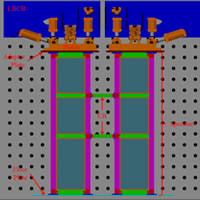Steel Plate Shear Walls

Steel plate shear walls (SPW) are a seismic lateral force resisting system used predominately in North America and Asia. The SPW system consists of a steel frame with web plates connected to the beam and columns of each story, referred to as Horizontal Boundary Elements (HBE) and Vertical Boundary Elements (VBEs) respectively. SPWs dissipate energy primarily through yielding of the web plates. The web plates provide significant strength and stiffness, allowing the use of thin web plates.
The web plate may be stiffened, common in Japan, to prevent out-of-plane buckling prior to shear yielding. However, the unstiffened SPW is much more common, particularly in the United States, and will be the focus of discussion. In an unstiffened SPW, the web plate buckles out-of-plane under negligible shear force. The diagonal tension field is similar to tension field action in plate girders; with the VBEs synonymous to the plate girder flanges, the web plates synonymous to the plate girder web and the HBEs synonymous to the plate girder stiffeners.

The SPW system has exhibited numerous benefits over other seismic lateral force resisting systems. Compared to concrete shear walls, SPWs are substantially thinner, reducing the lateral force resisting system footprint. Additionally, SPWs are lighter, reducing the seismic demands and resulting in more economical foundations. SPWs can be constructed at a similar rate to other steel seismic lateral force resisting systems, often faster than concrete systems. The web plates are able to develop significant strength and stiffness over relatively short lengths. Therefore they can be used efficiently in narrow bays where braced frames would be ineffective.
The web plates of SPWs inhibit building occupant movement through the bay of the seismic lateral force resisting system. Therefore, SPWs are often placed surrounding the building core, which typically contains the elevators and stairwells, to satisfy architectural requirements. However, building occupant movement requirements often dictate openings within the bay, leading to the placement of a pair of SPWs adjacently within a single bay. Adjacent SPW piers are typically designed to act independently. It is a logical extension of the SPW system to link two SPW piers together with Coupling Beams (CB) at the floor level to form a Steel Plate Shear Wall with Coupling (SPW-WC). The SPW-WC system retains the benefits of the SPW described in the previous section, particularly the high initial stiffness, stable hysteretic behavior and good ductility, while introducing the coupling beam as an additional source of energy dissipation. The SPW-WC system increases material efficiency compared to a pair of planar SPWs.

Limited research has been conducted on the SPW-WC system. Therefore, a seminal study of the Steel Plate Shear Wall with Coupling system was initiated in order to fill this critical knowledge gap. This work addresses the mechanisms and design of the SPW-WC system. The performance of the SPW-WC system is explored with a numerical parametric study. A large-scale testing program is planned to further study the behavior of the system. Ultimately, design recommendations will be developed in order to aid the widespread adoption of the SPW-WC system.
An experimental test program was developed in order to further study the behavior of the Steel Plate Shear Wall with Coupling (SPSW-WC) system. The experimental test program was devised to study the global response, internal force distribution, local demands and failure modes of the SPSW-WC system. Large-scale testing was selected to accurately represent the member proportions and to facilitate the use of typical detailing. The testing will be conducted at the University of Illinois at Urbana-Champaign in the NEES MUST-SIM facility. Two large-scale specimens were designed to represent the lower three stories of a six story prototype structures at approximately half-scale.

